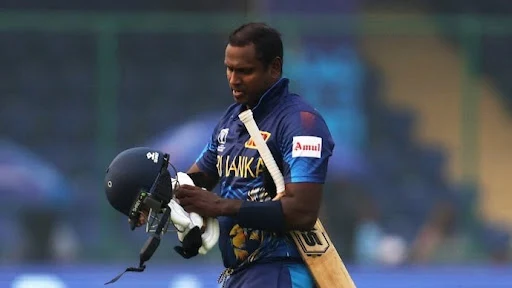The 'timed out' dismissal of Angelo Mathews in the BangVsSL ODI World Cup 2023 in Delhi created a buzz and demanded an explanation for a rule that had never been applied in international cricket before. Due to problems with his helmet, the former captain of Sri Lanka waited more than 2 minutes to take up the batting position. Shakib Al Hasan, the captain of Bangladesh, appealed at this time, and the on-field umpire upheld it. What do you think?? What Shakib Al Hasan done it is against the spirit of sportsmanship?? And It creates more controversies against Bangladesh Cricket Board also??
What is a Timed Out in Cricket?
Rule 40.1.1 states: When a wicket falls or a batsman retires, the next batter must be ready to receive the ball within 3 minutes of the previous batter being dismissed or retiring. The hitter who is about to bat will be out and timed out if this condition is not met.
Rule 40.1.2, the umpires will follow Law 16.3 - if there is a prolonged delay and no batter reaches the wicket. According to that law, the action will begin when the 3 minutes mentioned above have elapsed.
It should be mentioned that, similar to the run-out situation, the bowler receives no credit for this dismissal.
When Mathews got back to the dugout, he was furious and sad. Much like the non-striker run-out, the form of dismissal is expected to create a controversies,buzz and debate on social media, among fans and experts of the game.
The Timing Aspect
When it comes to cricket, sportsmanship is everything. Every move in the game, from the bowler's run-up to the batsman's strike, is precisely timed. There's no exclusion to the timed out rule. It usually takes the new batsman 3 minutes to come to the crease and get ready for the following delivery. The fielding side has the option to proclaim the batsman "Timed Out" if they take longer than the allotted time.
Umpire's Decision
The on-field umpire decides whether to tag a batsman as "Timed Out". The umpire's job is to keep an eye on the incoming batsman's time and determine if they have gone over the allotted three minutes. This is final and cannot be overturned or reviewed with the aid of DRS (Decision Review System) technology.
Practical Application
Real-world match conditions rarely result in timed outs. Batsmen try to get to the crease as soon as possible, usually knowing that they have a limited amount of time. though, delays can be brought on by outside variables like accidents. These are things that umpires frequently consider and employ their judgment when enforcing the regulation.
The Impact:
A timed out in cricket can have a significant impact on a match. It can add more pressure on the batting side, especially when they are chasing a target or trying to build a partnership. The sudden loss of a batsman can disrupt their rhythm and give more pressure to batting team and give the fielding side an advantage. That's why teams pay close attention to time management and ensure that their batsmen are ready to go when it's their turn.
Conclusion
The timed out law in cricket is a unique and lesser-known aspect of the game. It enhances the sport's allure and complexity, and knowing these regulations only broadens one's appreciation for it. You'll understand the meaning of "Timed Out" and its purpose the next you're watching a cricket match.
We hope that this explanation has helped to clarify the meaning of timed outs in cricket and lessen the mystery surrounding this part of the sport. Maintain your enjoyment of the gentleman's game while appreciating this law?? Comment your views on this law?? Is it against the sportsmanship??





0 Comments